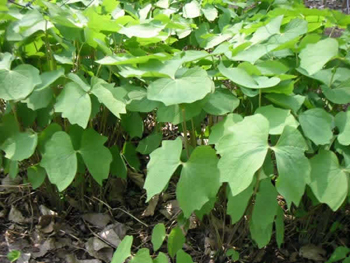Contents:
Common Names | Parts Usually Used | Plant(s) & Culture | Where Found | Medicinal Properties | Biochemical Information
Uses | Formulas or Dosages | Warning | Bibliography
Scientific Names

- Jeffersonia diphylla L.
- Berbidaceae
- Barberry family
Common Names
- Ground squirrel pea
- Helmet pod
- Jeffersonia
- Rheumatism root
- Twin leaf root
- Yellowroot
Parts Usually Used
The whole plant, root especially
Back to Top
Description of Plant(s) and
Culture
Twin leaf is a perennial plant; the horizontal, fleshy rootstock with matted fibrous roots produces a simple, naked scape, 12-18 inches tall. Emanating also from the rootstock, the large, smooth basal leaves, 3-6 inches long and 2-5 inches wide, are divided into 2 half-ovate leaflets. Blooming from April to May, a large, solitary, white, 8 petaled flower terminates the scape. The fruit is an obovate capsule. The plant is only 6-9 inches tall in flower, but is double that height in fruit.
Back to Top
Where Found
Grows in limestone soils and in woods near rivers from Ontario westward to Wisconsin and southward to Virginia and Tennessee. Too rare to harvest.
Back to Top
Medicinal Properties
Antirheumatic, alterative, antispasmodic, antisyphilitic, diaphoretic, diuretic, emetic, expectorant, tonic
Back to Top
Biochemical Information
Bitter substance, an acrid and nauseating constituent, pectin, fatty resin, tannic acid, gum starch, sugar and mineral matters
Back to Top
Uses
Twin leaf is used for chronic rheumatism, nervous and spasmodic problems, neuralgia, headaches, especially headaches with dizziness and feelings of tension, stress, syphilis, scarlatina, scarlet fever, diarrhea, kidney gravel, dropsy, urinary infections, and cramps. In small doses, it is used as an expectorant and a tonic; in large doses, as an emetic. As a gargle, it is useful for throat infections. Applied externally as a poultice or fomentation, it will relieve pain anywhere in the body, treats ulcers, sores, inflammations, and cancerous sores.
Back to Top
Formulas or Dosages
Decoction: steep 1 tsp. root in 1 cup boiling water for 30 minutes, then simmer 10 minutes and strain. Take 1 cup, then follow with small frequent doses.
Tincture: a dose is from 5 to 20 drops.
Back to Top
Warning
Too rare to harvest. Probably toxic.
Back to Top
Bibliography
![]() American Folk Medicine
American Folk Medicine, by Clarence Meyer, Meyerbooks, publisher, PO Box 427, Glenwood, Illinois 60425, 1973
![]() Back to Eden
Back to Eden, by Jethro Kloss; Back to Eden Publishing Co., Loma Linda, CA 92354, Original copyright 1939, revised edition 1994
![]() Eastern/Central Medicinal Plants
Eastern/Central Medicinal Plants, by Steven Foster and James A. Duke., Houghton Mifflin Company, 215 Park Avenue South, New York, NY 10000
![]() The Herb Book
The Herb Book, by John Lust, Bantam Books, 666 Fifth Avenue, New York, NY. copyright 1974.
![]() Planetary Herbology
Planetary Herbology, by Michael Tierra, C.A., N.D., O.M.D., Lotus Press, PO Box 325, Twin Lakes. WI 53181., Copyright 1988, published 1992
